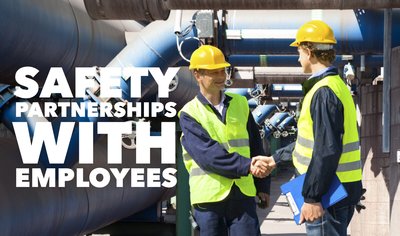How To Build Safety Partnerships With Employees
In order for a safety partnership to work, there has to be mutual benefit.
 The television shows Shark Tank (USA) and Dragon’s Den (Canada, UK, Australia) feature a panel of investors looking for a great product or idea to get behind. The entrepreneur makes a pitch to the investors. If the pitch is successful, the venture gets backing. If the pitch misses, or if the investors deem that there is too little benefit to them, they won’t invest.
The television shows Shark Tank (USA) and Dragon’s Den (Canada, UK, Australia) feature a panel of investors looking for a great product or idea to get behind. The entrepreneur makes a pitch to the investors. If the pitch is successful, the venture gets backing. If the pitch misses, or if the investors deem that there is too little benefit to them, they won’t invest.
If there is no advantage for an investor, they won’t invest. There has to be a benefit for both partners. And before you can invite employees to become partners in a work project, the benefits of safety have to be clear. In the safety partnership, each partner gets something out of the deal. So let’s explore ways of building partnerships.
Here are the first three steps into building safety partnerships with employees:
1Establish their win. Here’s where the biggest mistakes are made. Safety people assume they know best what the win is for employees. Then they tell the employee why safety is good for them. For the employee, it sounds, mostly, like they’re being talked down to. Employees hate being told what they want or what’s good for them. Experienced investors don’t need to be told why the investment makes sense for them. They can figure it out. Take the time to engage your people first. Ask them for their win. You may not get it right away. They may not come to it right away. It may take some time to explore why a person would suddenly change their mind on safety and begin to embrace it openly. But it is a part of a process. People want to be in control of the ideas and projects that they get behind.
2Make it tangible. Avoiding a loss is not tangible. For investors, “you won’t lose your money” is not a win. This is the second place where safety people make a mistake; selling the avoidance of a loss as a win. But avoiding a loss is not a win. It is status quo. “Not getting hurt” is not a win - especially if they’re not hurt now. It’s just a continuation of what they’ve been doing. And they can “not get hurt” by tolerating safety rules and procedures without actually buying-in. Maybe the real win for some employees is that buying-in to safety would increase the level to which they are trusted. Or perhaps an employee’s chances of being promoted rise radically if they would just buy-in to safety. After all, companies are unlikely to promote an employee to supervisor if they shortcut safety. If people want to move up, safety needs to be one of their guiding principles if they are going to lead others. But avoiding a loss is not a tangible idea or strategy to help build a partnership in safety.
3Become a trusted advisor. On the TV shows above, occasionally an entrepreneur wants to get on the phone to ask their advisor for input on a counter-offer. We all have people in our lives that we look up to as people whose advice we would follow. You need to become that trusted advisor. You don’t buy a car from the brochure. You don’t buy a house from a web site. You weigh options and benefits. If you don’t have enough information, you ask advice from someone you trust. Those people who you admire and trust greatly, you will listen to what they have to say. You will likely invest in the same things as those you admire, trust and respect. If they asked you to be an investor, you would likely go along if you could see your win. If you want to be able to help others come to safety, you will need to earn trust. Make them feel valued and place people above numbers.
 Make safety buy-in about what your employees, your partners, gain. Not what they may potentially lose if they don’t invest. In order for a partnership to work, there has to be mutual benefit. Viewing safety as a partnership comes from respect. Inspire your people, and value them, and trust them, and involve them in safety. They are more likely then prepared to become partners.
Make safety buy-in about what your employees, your partners, gain. Not what they may potentially lose if they don’t invest. In order for a partnership to work, there has to be mutual benefit. Viewing safety as a partnership comes from respect. Inspire your people, and value them, and trust them, and involve them in safety. They are more likely then prepared to become partners.
When your employees become partners in safety, they become people who buy-in to safety. Everyone wants to be treated as valuable and capable. When they are treated with respect they will take ownership of safety as a whole - not just the checklist. When they take ownership, pride ensues. When pride is involved, standards are raised.
Kevin Burns has authored ten books on human performance and safety, including his most recent release, PeopleWork - The Human Touch in Workplace Safety. Buy it now on Amazon. Then, consider bringing Kevin's consulting expertise to your company or have him speak at a safety event.
©2017 ZeroSpeak Corporation and Kevin Burns.
No part of this post may be reproduced without the expressed consent of the author.


